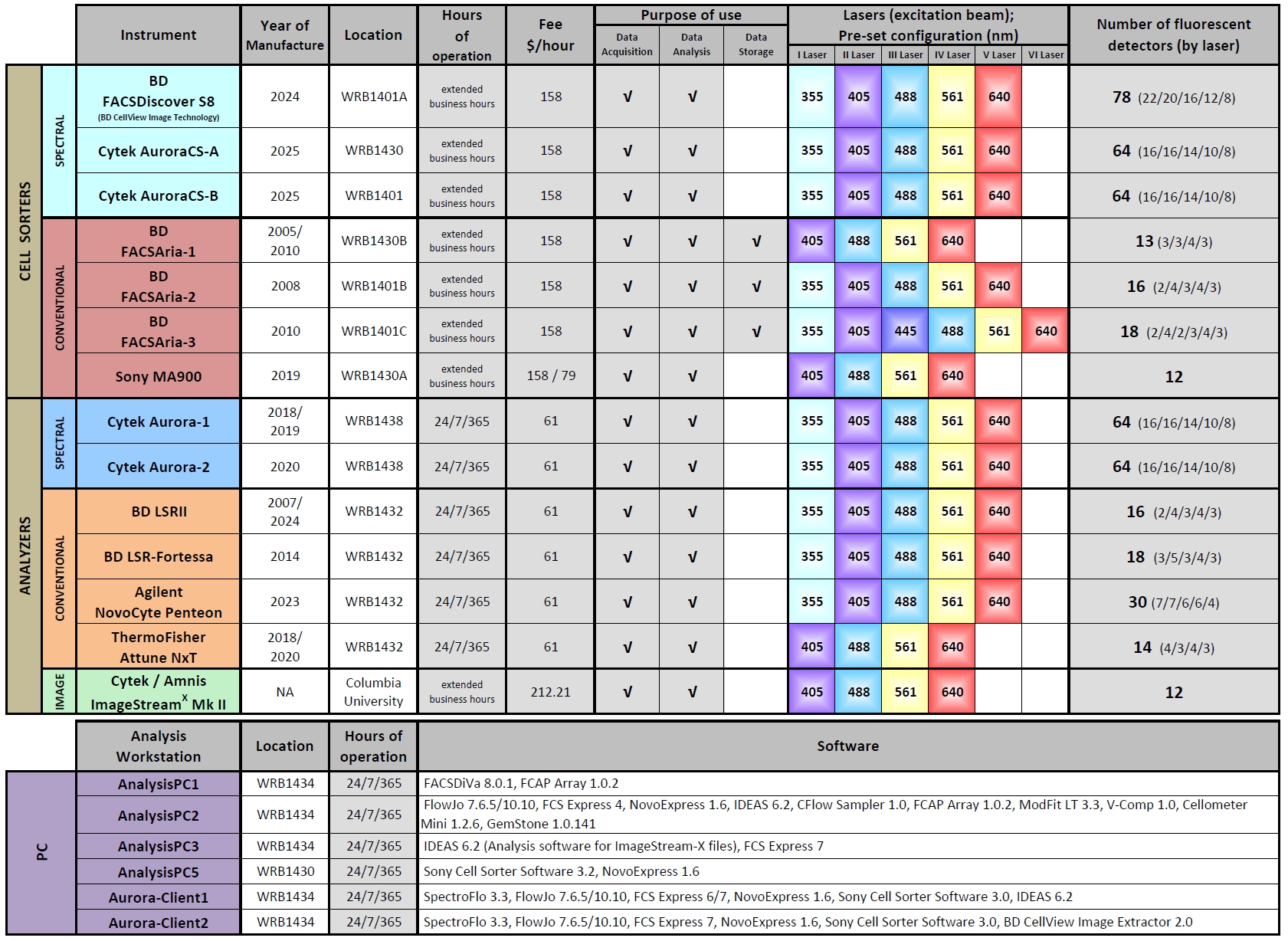Instruments
BD LSR (BD LSRII and BD LSR-Fortessa)
Cytek/Amnis ImageStreamX MkII (at Columbia University)
Instruments Retired:
BD LSRII-1 and BD LSRII-2(opens in new window)
For cell sorting, the FCRC at RU is equipped with three BD FACSAria Cell Sorters from BD Biosciences and one MA900 cell sorter from Sony Biotechnology. All instruments provide high-speed, high purity multi-laser cell sorting into up to four tubes and are also capable of sterile sorts of single cells directly into culture plates. Very recently, FCRC has added the BD FACSDiscover S8 Cell Sorter on board. As the first spectral flow cytometer sorter with sort-capable image analysis, FACSDiscover S8 can measure the entire emission spectra of the fluorescent dyes and sort cells based on not only fluorochrome staining but also on cell imaging features. BD FACSAria and FACSDiscover S8 cell sorters are operated by FCRC staff only. Sony MA900 can be operated by researchers with full time (24/7/365) access, after completion of the required training.
In September 2025, FCRC have two new cell sorters Aurora CS (Cell Sorter) coming from Cytek and are installed in temporary spaces for the next six months. The Cytek Aurora CS is an advanced and adaptable cell sorting system built with the power of Cytek’s Innovative Full Spectrum Profiling™ (FSP™) Technology that meets the diverse needs of your laboratory, while delivering the sorting functionality you would expect from a high-end sorter. Sharing the same optical system as the Cytek Aurora analyzer allows for the easy transfer of experiments from the analyzer to the Aurora CS system without the need to modify your panels. FCRC will share more details as soon as the instruments are ready for use.

For analysis purposes, the FCRC at RU is equipped with six benchtop analyzers, which cover the wide range of researcher’s needs:
The two spectral Analyzers Cytek Aurora have five lasers (355, 405, 488, 561 and 640 nm) and 64 fluorescence channels. It has a unique capability of measuring the entire emission spectra of the fluorescent dyes excited by multiple lasers installed on the instrument. The full spectrum capture enables the use of the novel unmixing algorithms for the further data analysis. Till now up to 43 different fluorescent labels could be resolved at same time, even when multiple markers are co-expressed on the same cell.
We also have four benchtop alignment-free multipurpose conventional analyzers. Two of them from BD Biosciences: BD LSRII and BD LSR-Fortessa. The laser configurations on the LSR instruments allow for analysis of cell samples stained with 488, 640, 355 (UV), 405 and 561 nm excited dyes. A number of applications, including the multicolor analysis of cell phenotype, gene expression, cell cycle, and others may be performed. Agilent NovoCyte Penteon(opens in new window) is equipped with five lasers (355, 405, 488, 561 and 640 nm) and 30 ultimate photodetectors, which provides an expanded set of capabilities that accommodate today’s high-end and increasingly sophisticated multi-color flow cytometry assays with its laboratory automation platforms for FACS tubes (40-tube rack) and 24-, 48-, 96-, and 384-well plates. ThermoFisher Attune NxT is a conventional analyzer equipped with four lasers (405, 488, 561 and 637 nm) and 14 fluorescence channels. Using the unique acoustic focusing feature, the Autosampler enables Attune to run samples tubes or in plate formats, including 96-well, 384-well, and deep-wells with the high volume intake.
After orientation trainings (Virtual Classroom, “Beyond the Basics” Class, Pre-Hands-On Consultation and Instrument Hands-On Training), Cytek Aurora, BD LSRII, BD LSR-Fortessa, Agilent NovoCyte Penteon and ThermoFisher Attune NxT are available for use directly by the investigators.
By the collaboration with the Columbia University Stem Cell Initiative (CSCI) Flow Cytometry Core (FCC),(opens in new window) FCRC facilitates access to ImageStream service for RU researchers to use the unique Cytek / AmnisⓇ ImageStreamX Mk II Imaging Cytometer. To access to the instrument, RU researchers need to request on PPMS system for initial internal consultation(opens in new window) from FCRC Staff, followed by meeting with the CSCI FCC(opens in new window) Director of Operations , Michael Kissner for the Experimental Design and Data Analysis Consultation to discuss experiment-specific details and schedule experiment(s).
Click to Enlarge.
